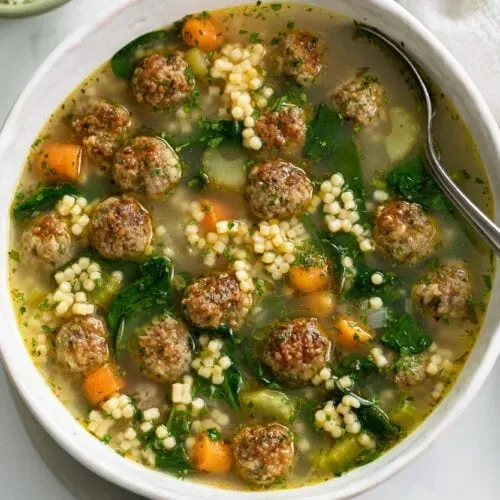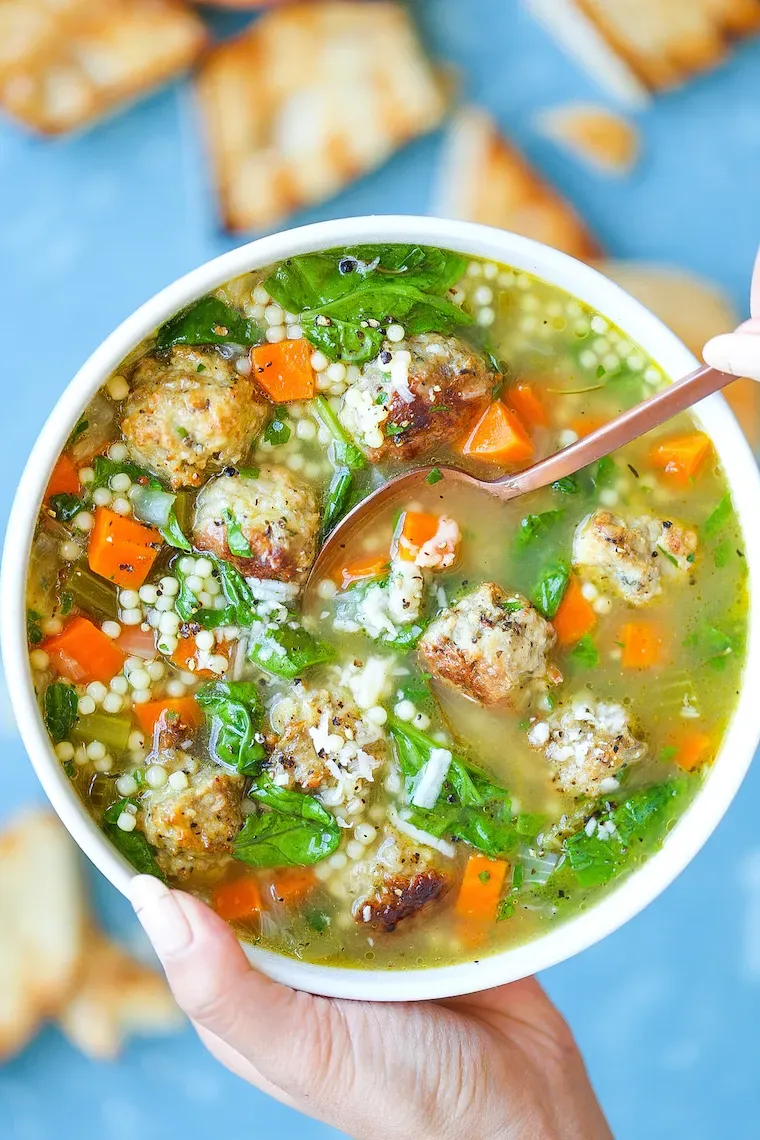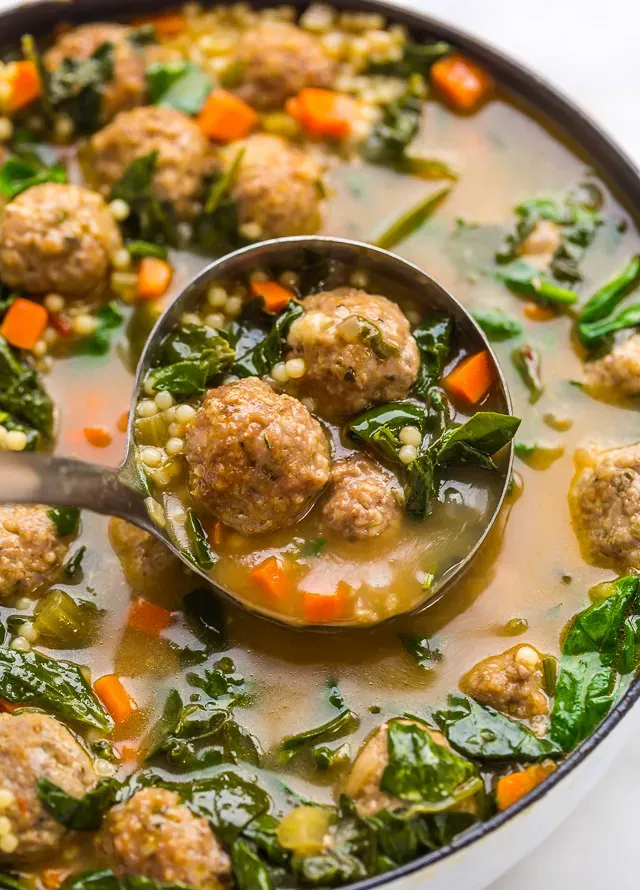Table of Contents
You've probably seen "Italian Wedding Soup" on countless menus, maybe even tried a few bowls. It's that comforting mix of little meatballs, greens, and tiny pasta swimming in broth. But here's a little secret: it's not actually served at Italian weddings. The name "wedding soup" comes from the Italian phrase "minestra maritata," meaning "married soup," referring to the flavorful "marriage" of greens and meat. So, while you're searching for the perfect italian wedding meatball soup recipe, know you're looking for a delicious, traditional Southern Italian dish, just maybe not one you'd find next to the wedding cake. This article is your guide to making the real deal. We'll dive into crafting those tender, flavorful meatballs, simmering a rich broth, finding the right greens, and adding that essential pastina. Forget the Americanized versions; let's make the soup that celebrates a true union of simple, fresh ingredients.
Beyond the Name: What is Italian Wedding Meatball Soup, Really?

Beyond the Name: What is Italian Wedding Meatball Soup, Really?
It's Not What You Think (Unless You're Italian)
Let's clear the air right away. If you're looking for an authentic italian wedding meatball soup recipe because you picture little bowls being passed around at a Tuscan reception, you've got the wrong idea. The name "Italian Wedding Soup" is a bit of a linguistic mix-up that happened somewhere between Italy and America. The actual Italian name is "minestra maritata," which translates to "married soup."
This "marriage" isn't between two people saying "I do." It's a culinary union. The term refers to the delicious combination, the perfect pairing, of green leafy vegetables and meat in a single pot. Think of it as a flavor marriage, not a matrimonial one. It's hearty, comforting, and deeply rooted in tradition, just not the wedding kind.
A Southern Italian Staple, Not a Wedding Dish
Minestra maritata is a classic dish, particularly from the Campania region of Southern Italy. It's peasant food, born from the need to make a flavorful, filling meal using readily available ingredients – typically tough greens that needed long simmering and leftover bits of meat. You'd find this soup served as a first course, a substantial beginning to a meal, not necessarily part of a multi-course wedding feast.
It's the kind of soup nonna would make on a chilly day, using whatever greens were fresh from the garden or market, and tiny meatballs made from a mix of meats, or sometimes just pork or beef. It's about making something wonderful from simple components, a testament to Italian cucina povera – "poor kitchen" cooking that is anything but poor in flavor.
Traditional Components of Minestra Maritata
- Tiny Meatballs (polpettine)
- Leafy Greens (escarole, chicory, kale, sometimes cabbage)
- Broth (often meat-based, sometimes with vegetables)
- Small Pasta (pastina like acini di pepe, stelline, or even broken spaghetti)
The American Adaptation vs. The Original
The version of Italian Wedding Soup you often find outside of Italy has evolved. The meatballs tend to be bigger, more uniform. The greens are almost always spinach, which wilts quickly but doesn't offer the slight bitterness or texture of traditional chicory or escarole. Sometimes carrots and celery make an appearance in the broth, which isn't always traditional.
While the Americanized version is certainly tasty and beloved, understanding the origin helps you appreciate the nuances of a truly authentic italian wedding meatball soup recipe. It's about smaller, more rustic meatballs, heartier greens, and a focus on the rich, savory broth that ties it all together. It's a dish with a story, and knowing that story makes eating it even better.
The Heart of the Bowl: Perfecting the Meatballs for Your Italian Wedding Meatball Soup Recipe

The Heart of the Bowl: Perfecting the Meatballs for Your Italian Wedding Meatball Soup Recipe
Why Tiny Meatballs Matter
let's talk meatballs. They are the star, the tiny flavor bombs in your italian wedding meatball soup recipe. Forget those giant golf balls you sometimes see. Authentic minestra maritata calls for *polpettine*, little meatballs, maybe half an inch across, tops. Why so small? Because they cook quickly and evenly right in the simmering broth, infusing it with meaty goodness. Plus, you get several in every spoonful, which is just more satisfying. Making them small also means you get more surface area for that delicious browning before they hit the soup, locking in flavor.
Crafting Your Perfect Polpettine
Making these little guys isn't complicated, but a few things make a big difference. You want a mix of meats for the best flavor and texture – ground beef and pork is classic. Some recipes even throw in a bit of veal. Breadcrumbs (stale bread soaked in milk and squeezed dry is better than dry crumbs) keep them tender, and grated Parmigiano Reggiano is non-negotiable for that salty, nutty depth. Don't forget garlic, parsley, an egg to bind, and a good pinch of salt and pepper. Mix gently – overmixing makes tough meatballs, and nobody wants that. Roll them small, quick little spheres between your palms.
Essential Meatball Ingredients
- Ground Beef
- Ground Pork (or Veal)
- Stale Bread (or Panko)
- Milk
- Parmigiano Reggiano
- Egg
- Fresh Parsley
- Garlic
- Salt & Pepper
Broth, Greens, and Bringing the "Marriage" Together

Broth, Greens, and Bringing the "Marriage" Together
Building the Flavor Foundation: The Broth
Alright, you've got your tiny meatballs ready to go. Now let's talk broth. This isn't just hot water; it's the soul of your italian wedding meatball soup recipe. A good broth is the difference between something forgettable and a soup that makes you close your eyes and sigh happily. Traditionally, this soup uses a simple meat broth, often beef or chicken, sometimes a mix. You want something clean and savory, not overly complicated. Forget those sad, watery cartons from the store if you can. Making your own from bones or even just simmering good quality stock with an onion and a carrot for an hour makes a world of difference. It needs to be flavorful enough to stand up to the greens and meatballs without overpowering them.
Choosing Your "Married" Greens
The "marriage" part of minestra maritata really shines here. We're talking greens, and while spinach is the go-to in many American kitchens, the classic choices are heartier, with a bit more character. Escarole is fantastic – it has wide, slightly bitter leaves that soften beautifully. Chicory is another excellent option, bringing a pleasing earthiness. Some folks even use kale, though you'll want to chop it finely and give it enough time to tenderize. The key is greens that hold their shape and offer a slight counterpoint to the richness of the meatballs. They shouldn't just disappear into the broth; they should be a distinct, flavorful component.
Traditional Greens for Minestra Maritata
- Escarole (scarola)
- Chicory (cicoria)
- Curly Endive (indivia riccia)
- Sometimes Cabbage (verza)
The Union in the Pot: Simmering it All Together
With your broth simmering and your greens prepped, it's time for the "marriage" ceremony in the pot. You typically add the greens first, letting them wilt and soften in the hot broth. This helps mellow out any bitterness. Once the greens are tender but still holding their own – maybe 10-15 minutes depending on what you're using – it's time for the stars: your tiny meatballs. Gently drop them into the simmering soup. They cook remarkably fast, often in just a few minutes, as they're so small. As they cook, they release their flavor into the broth, enriching it further. This is where the magic happens, the simple elements coming together to create something greater than the sum of its parts.
Adding the Pastina and Serving Up Comfort

Adding the Pastina and Serving Up Comfort
The Tiny Pasta Finale: Cooking the Pastina
so you've got your beautifully "married" greens and meatballs simmering away in that rich broth for your italian wedding meatball soup recipe. The final essential component is the pastina. This isn't just any pasta; it's *pastina*, meaning "little pasta." Think tiny shapes – acini di pepe (peppercorns), stelline (little stars), orzo (though technically rice-shaped, it works), or even fregola sarda (tiny toasted balls). The crucial point here is *how* you cook it. Do NOT dump dry pastina directly into the main soup pot. It will soak up too much broth, turn mushy, and release starch that makes your beautiful soup cloudy and gluey. Cook the pastina separately in its own pot of salted water until al dente. Seriously, cook it separately. Drain it well.
Bringing it All Together and Serving
Once your pastina is cooked and drained, you have a couple of options for serving your italian wedding meatball soup recipe. The traditional way is to add a spoonful or two of the cooked pastina directly into the bottom of each serving bowl *before* you ladle in the hot soup. This keeps the pastina from getting overcooked and allows everyone to customize how much pasta they want. Ladle the steaming soup, making sure each bowl gets a good mix of broth, greens, and those precious little meatballs. A final flourish of grated Parmigiano Reggiano is non-negotiable. This soup is a meal in itself, hearty and deeply satisfying, perfect for a chilly evening or whenever you need a bowl of pure comfort.
Popular Pastina Shapes for Wedding Soup
- Acini di Pepe (like tiny beads)
- Stelline (little stars)
- Orzo (rice-shaped, slightly larger)
- Farfalline (tiny bow ties)
Beyond the Wedding: Enjoying Your "Married" Soup
So there you have it. Your own bowl of minestra maritata, the soup where humble greens and savory meatballs tie the knot in a flavorful broth. No fancy wedding required, just good ingredients and a little time over the stove. This isn't just soup; it's a taste of Southern Italian comfort, a dish that proves simplicity often yields the richest rewards. Serve it hot, savor each spoonful, and remember that sometimes, the best marriages happen right in your soup pot.